- Chinese regulators ratchet up the clampdowns
- Reflation trade remains in play
- Treasuries jumped Wednesday on muted data but technicals suggest selloff to resume
- Eurozone Trade Balance is released on Friday.
- Michigan Consumer Sentiment for August also prints on Friday.
- The FTSE 100 fell 0.2%
- The Stoxx Europe 600 was little changed
- Futures on the S&P 500 were flat
- Futures on the NASDAQ 100 fell 0.2%
- Futures on the Dow Jones Industrial Average held steady
- The MSCI Asia Pacific Index fell 0.4%
- The MSCI Emerging Markets Index fell 0.5%
- The British pound was little changed at $1.3863
- The Dollar Index was little changed
- The euro held at $1.1734
- The Japanese yen was unchanged at 110.43 per dollar
- The offshore yuan rose 0.2% to 6.4794 per dollar
- Britain’s 10-year yield was little changed at 0.57%
- The yield on 10-year Treasuries advanced one basis point to 1.34%
- Germany’s 10-year yield was little changed at -0.46%
- Brent crude fell 0.2% to $71.29 a barrel
- Spot gold rose 0.2% to $1,755.05 an ounce
Key Events
US futures for the Dow Jones, S&P 500, NASDAQ and Russell 2000 were mixed though relatively flat on Thursday and European stocks eked out marginal gains following this morning's decline—the first this week—for Asian benchmarks as China's regulatory clampdown accelerated. Strong earnings results in Europe from an array of insurers offset a drop in mining shares.
Treasury yields, along with the dollar, slipped.
Global Financial Affairs
Contracts on the small-cap Russell 2000 and the mega-cap Dow, both of which list value stocks, held steady, bolstering the ongoing case for a Reflation Trade paradigm shift, while SPX and NASDAQ futures declined.
In Europe the focus was a bit more fine-tuned. Sectors that benefit from a reopening economy were in the green. A rally in travel and leisure related stocks countered a selloff of mining firms, as commodities are still being pressured by the stronger US dollar, notwithstanding today's tick lower for the global reserve currency. The pan-European STOXX 600 has been wavering, but at time of publication it appears to be extending its rally for a 9th consecutive day.
Dutch life insurance giant Aegon NV (AS:AEGN) gapped higher by almost 3%, after beating earnings estimates. Shares then extending gains, bringing the stock to its highest level since May 12. Additional sector gainers after better than expected earnings releases included the UK's Aviva (LON:AV) and Switzerland's Zurich Insurance Group AG (SIX:ZURN).
Germany’s largest IT services company Bechtle AG (DE:BC8G) plunged 4.7%, wiping out six days of gains, on earnings disappointment. German hotel and tour operator Tui (DE:TUIGn) rose 2.6% on a substantial increase in holiday bookings. However, the technical chart is revealing weakness.
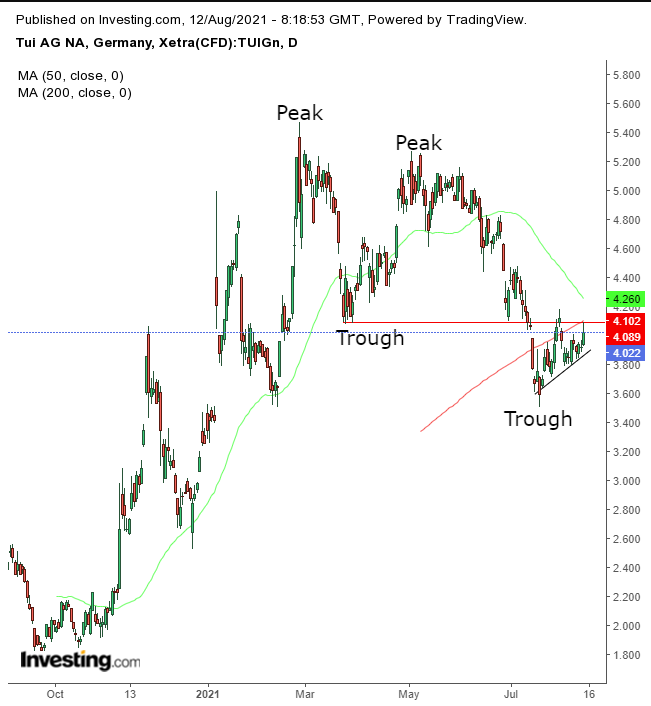
After an earlier 4.4% surge, the stock has now retreated to a 2.6% gain, after bumping into the 200 DMA. That occurrence, along with the previous March low, is forcing the price into a small H&S continuation pattern which is headed lower, after establishing a downtrend, as the 50-DMA bears down on the 200-DMA, threatening the ominous Death Cross.
Earlier Thursday in Asia, regional benchmarks, including Japan's Nikkei 225, Hong Kong's Hang Seng and the Shanghai Composite, all slumped after Chinese officials unveiled a five-year plan for additional tightening business regulations, as Beijing clamps down even harder on a variety of businesses, including fintech companies, educational and tutoring firms. Understandably, government sanctioned measures are unnerving investors.
Sino regulators are now setting their sights on online insurance companies. In the background, and providing additional market pressures, China is still fighting the fast-spreading COVID virus. Yesterday, after a worker at the world's third-largest container port in Ningbo-Zhoushan tested positive, China partially shut down operations until further notice citing a "system disruption."
During the Wall Street session on Wednesday, both the Dow Jones Industrial Average and the S&P 500 extended all-time highs, even as Treasuries rebounded after muted inflation data eased worries about the Fed rushing to remove stimulus that had propelled the US economy out of its worst recession in 80 years, fueled by the worst global health crisis in a century.
Yesterday's US CPI reading was in line with economist expectations—0.5% MoM and 5.4% YoY. The core reading, which excludes food and energy, and is the measure preferred by policy makers, increased only 0.3% monthly and 4.3% YoY.
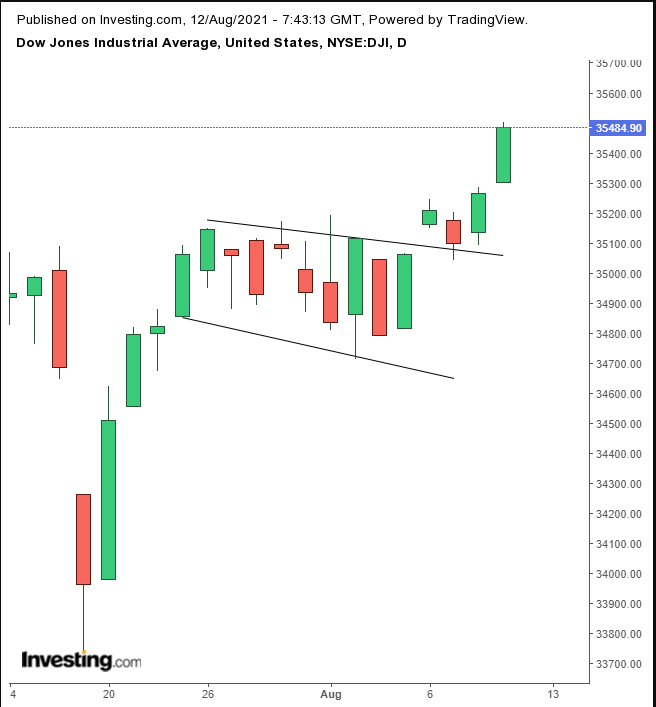
The 30-component Dow scored back-to-back records after completing a falling flag, bullish after the preceding five day straight rally.
While the value of the S&P 500 has doubled since the index bottomed in March 2020 at the height of the pandemic, the tech heavy-NASDAQ 100 is up nearly 125% over the same period. With tech shares that much more overstretched, no surprise that the NASDAQ Composite indices underperformed, confirming yet again that the Reflation Trade is back in play.
Treasuries, including the 10-year benchmark note, gave up some of yesterday’s gains after the muted inflation date indicated the path to higher interest rates will likely be extended. Still, bond supply and demand suggests an ongoing rally in yields.

Rates, which are negatively correlated to the price of bonds and therefore move in mirror image, found resistance by a Death Cross below the downtrend line. The question remains whether the completion Monday of a small double-bottom will hold against these larger technical components.
The dollar paused after yesterday’s dip, mirroring the movement of yields.
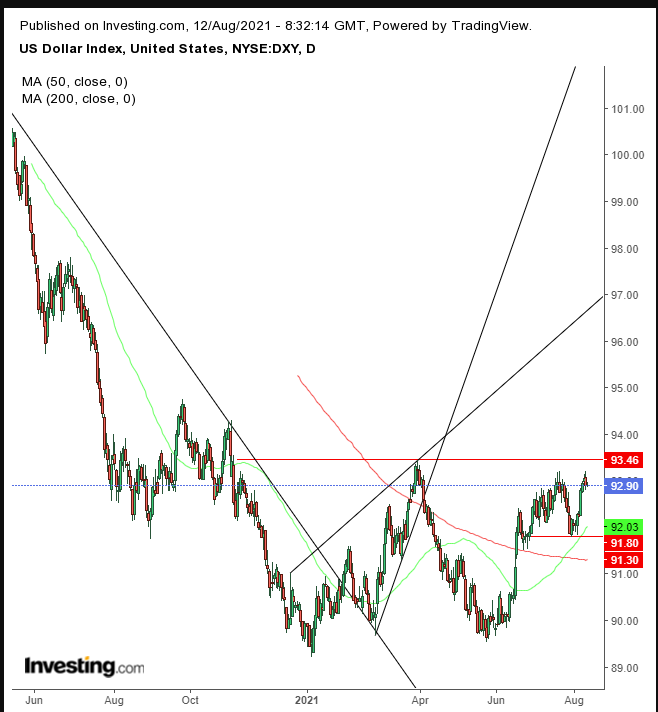
The greenback can now be expected to range between the neckline of a potential small double top and the massive double bottom in place since November. The Golden Cross suggests that's what will happen.
Gold was little changed as traders await another catalyst.
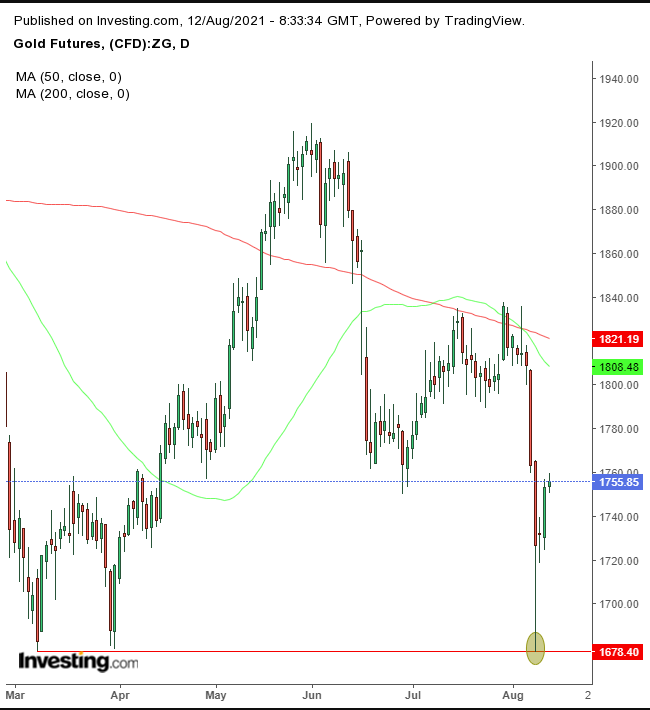
The price of the yellow metal is hovering at a support-resistance level dating back to late April, after a Death Cross was triggered.
Bitcoin edged lower for a third straight day.
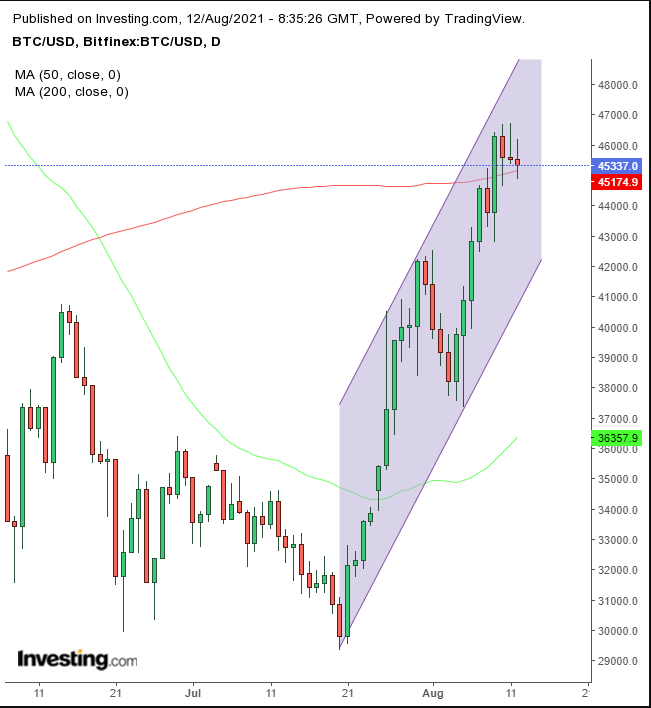
However, the cryptocurrency is being propped up by the 200-DMA inside a rising channel.
The softer dollar helped oil keep recent gains despite a smaller-than-anticipated drawdown in crude inventories.
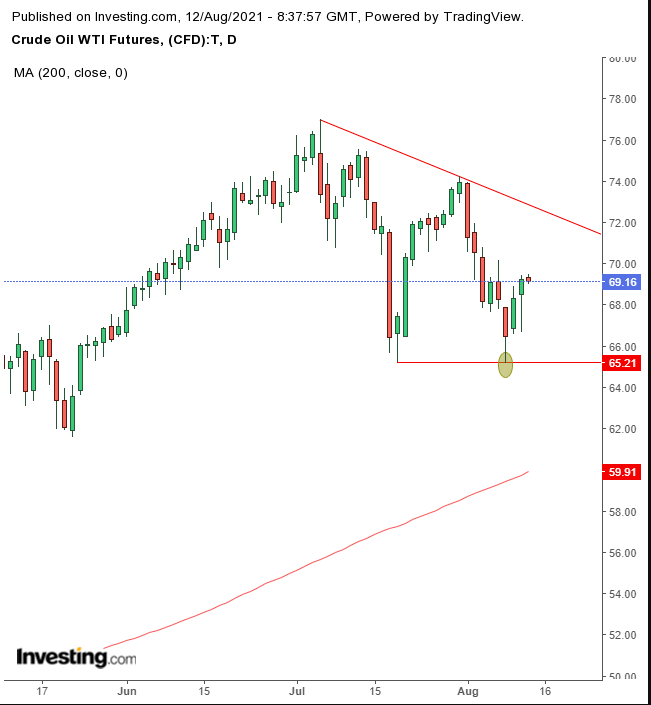
The price of WTI may be developing a descending triangle, as the 200-DMA heads higher, to support its bottom.
